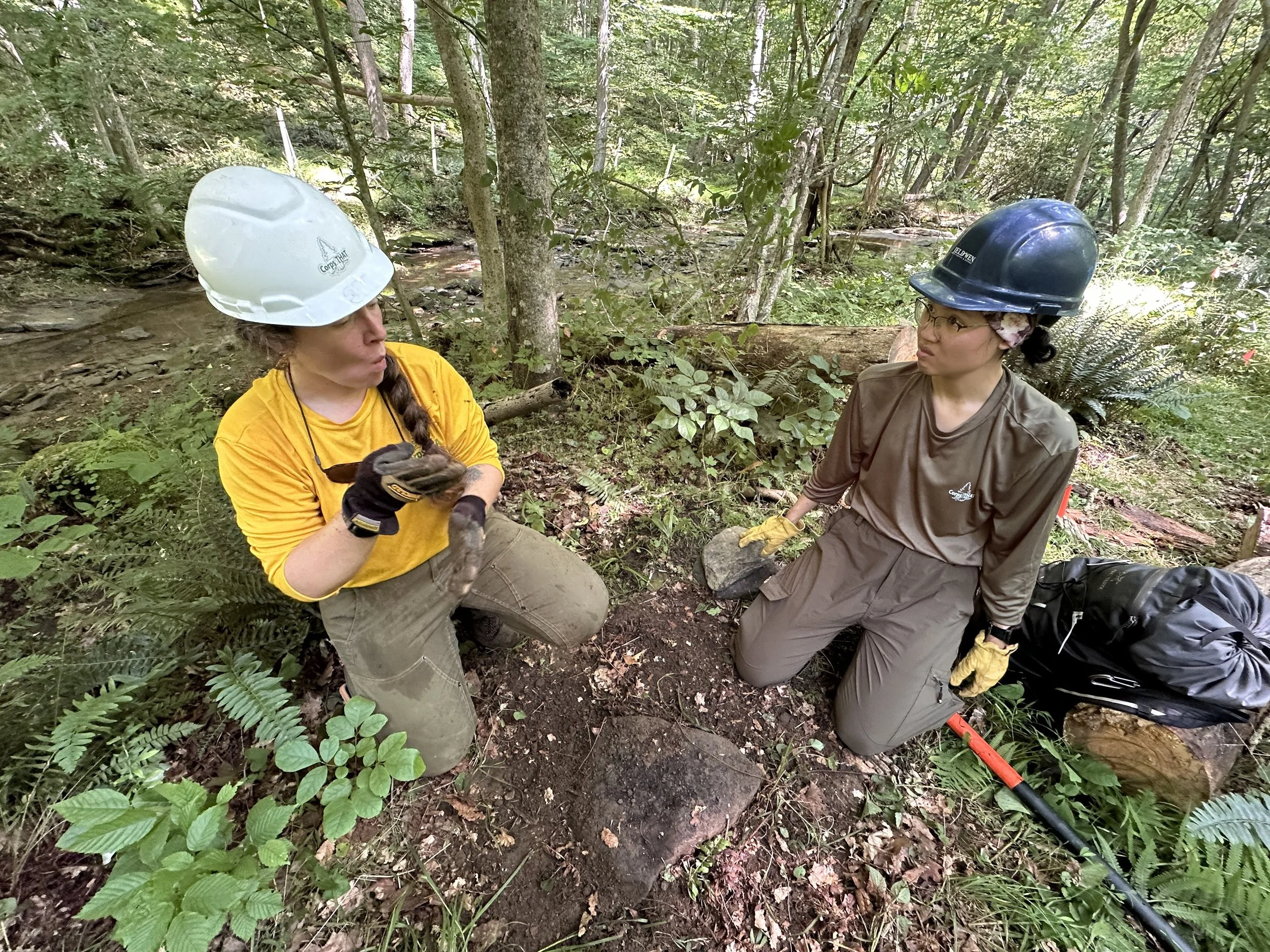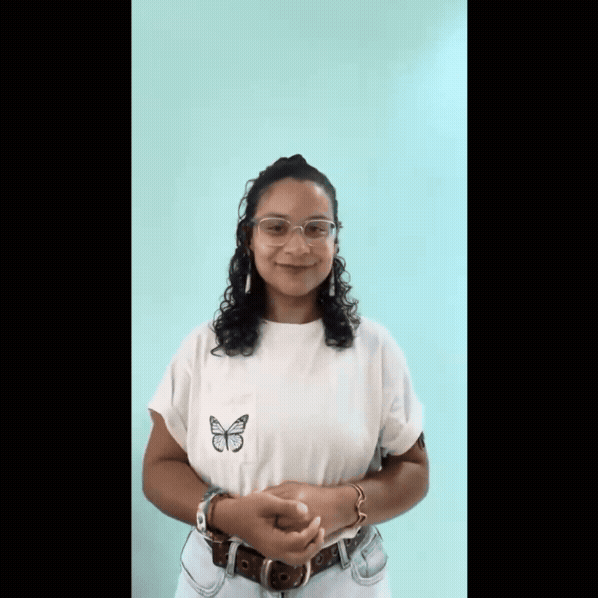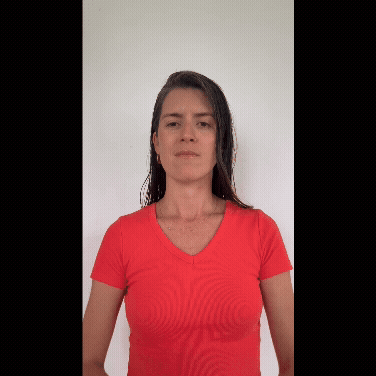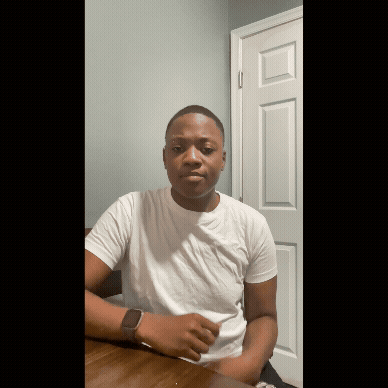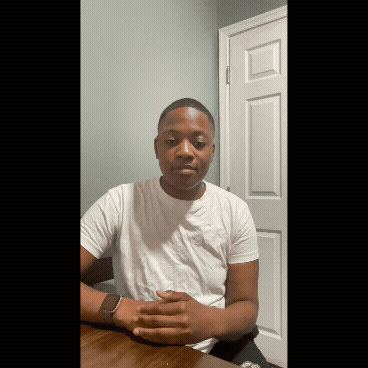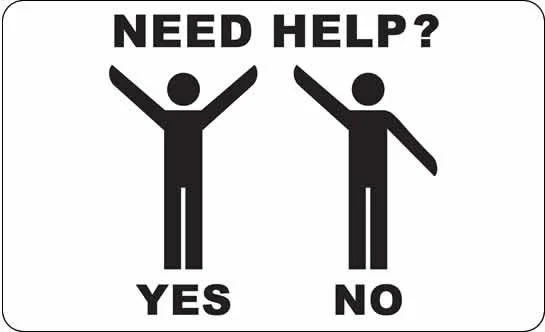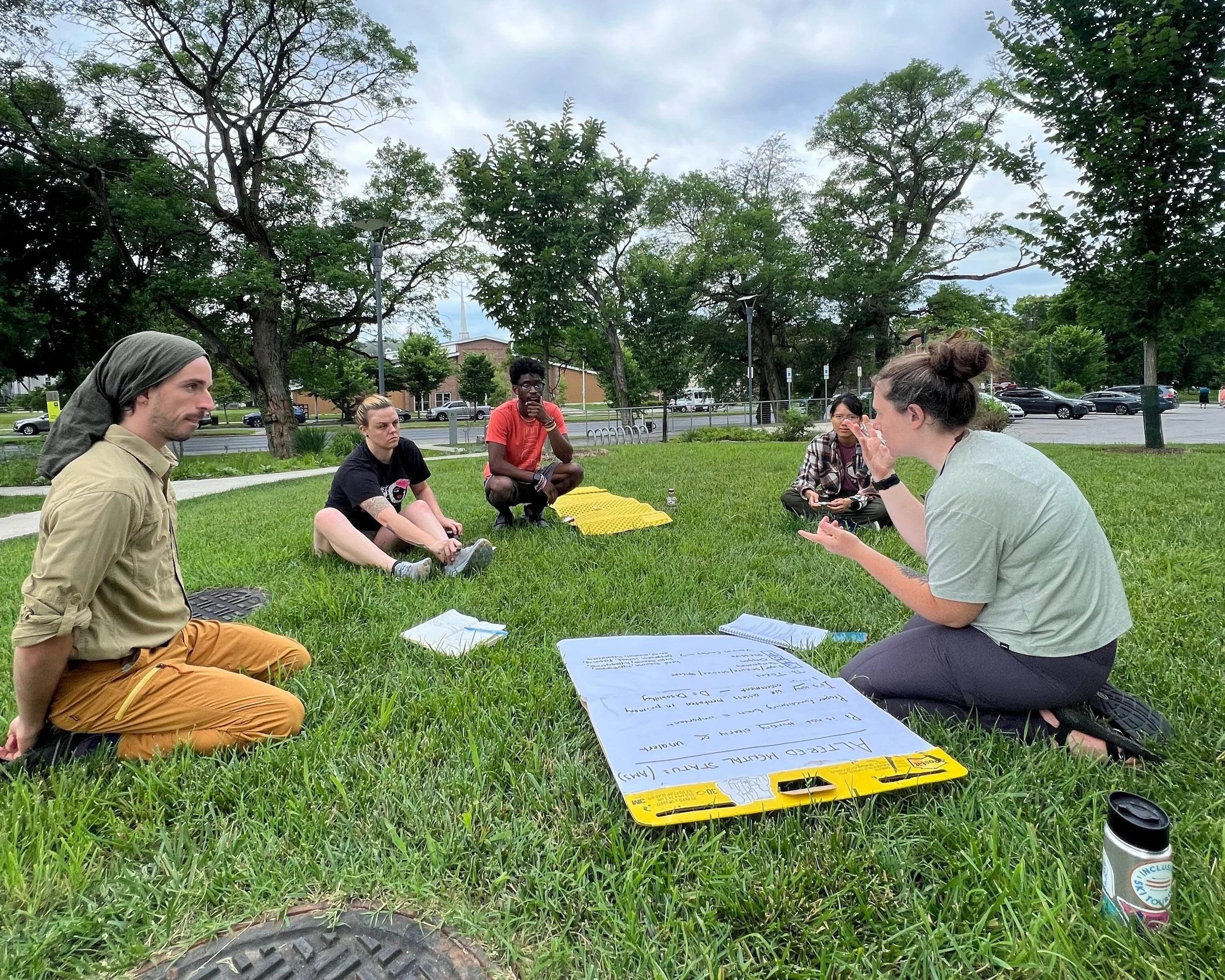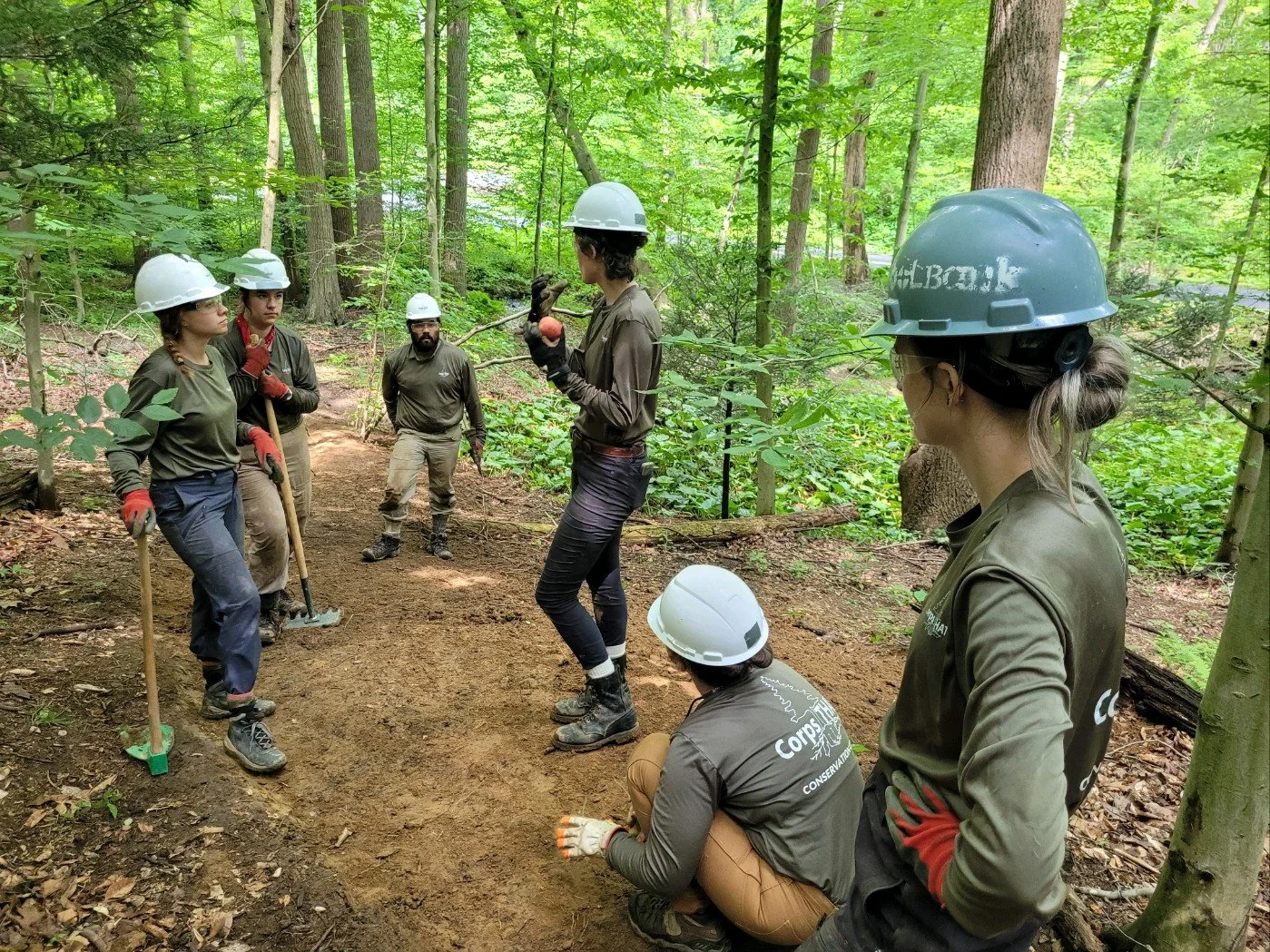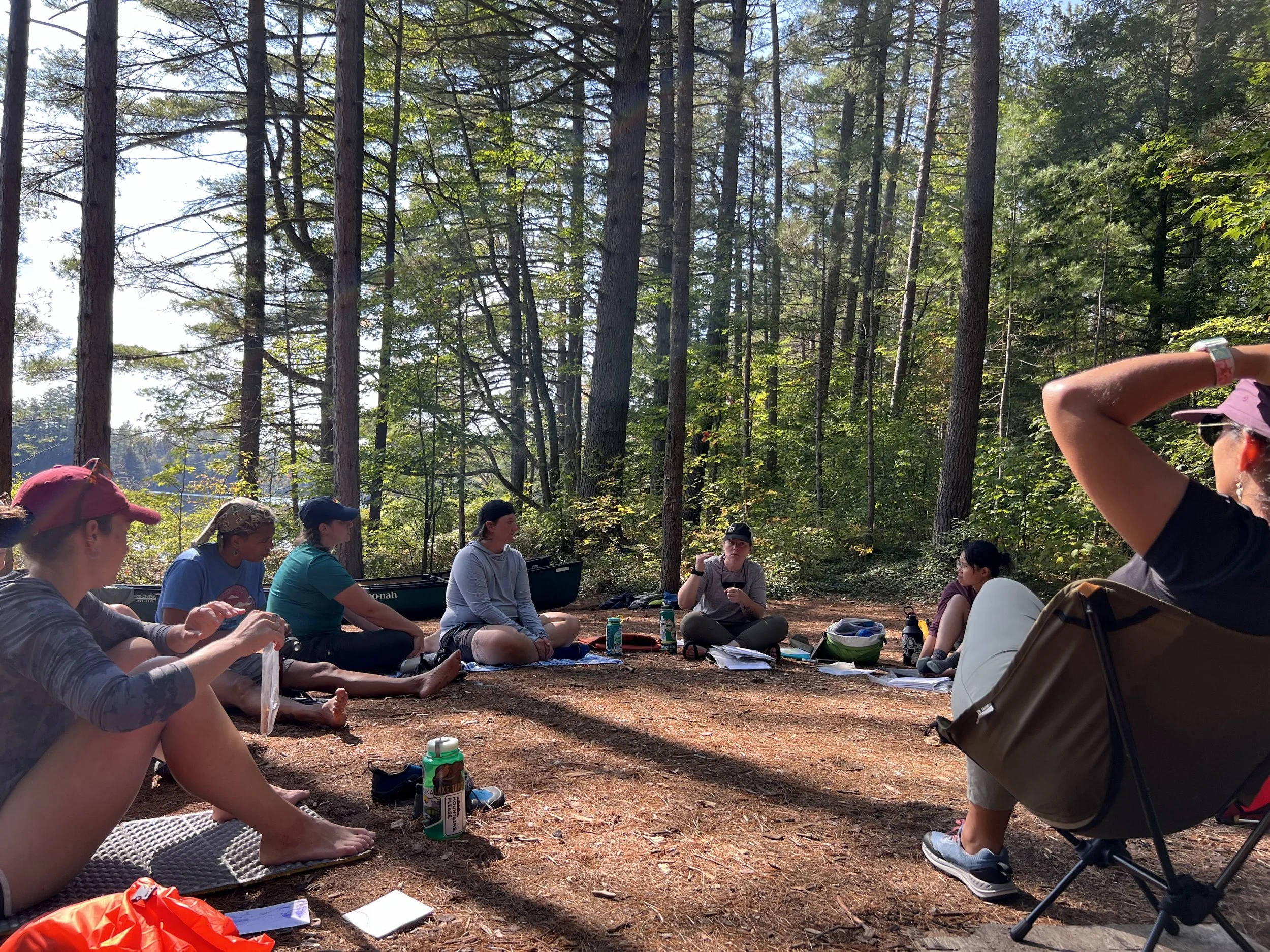Bridging the Communication Gap
Improving SAR communication with Deaf and Hard of Hearing teammates, subjects, and volunteers.
By Sam Bragg | May 19, 2025
Communication is perhaps the most important component to a successful rescue in the backcountry. Whether it’s within teams, with subjects, or between operational groups, effectively relaying information and asking clear questions is an incredibly important skill. But what do you do if the individual you’re working with has a different means of communicating?
Two trail workers with CorpsTHAT use ASL to communicate about their work.
Search and Rescue (SAR) teams often lack training in communicating with diverse populations, particularly Deaf and Hard of Hearing individuals. This gap in preparedness can result in delayed or ineffective response during emergencies. Additionally, SAR personnel may hold unexamined assumptions—such as viewing Deaf individuals as inherently at higher risk or as incapable of safely recreating in the outdoors. These biases can lead to exclusion, miscommunication, and decreased trust between SAR responders and the communities they serve. Ensuring equitable, respectful, and effective emergency response requires both communication training and a shift in mindset toward inclusion.
As someone who has worked in the field of conservation and outdoor education for years, I’ve seen firsthand how powerful nature can be in building confidence, leadership, and community. But I’ve also seen how inaccessible it can be — especially for Deaf and Hard of Hearing individuals. I’m passionate about this work because I believe that everyone, regardless of how they communicate, deserves not only to enjoy the outdoors but also to feel safe and supported in it.
What drives me is the recognition that the outdoor and emergency response fields have historically overlooked the needs and strengths of the Deaf community. I’ve witnessed moments where miscommunication in critical situations could have been avoided with just a bit of training and understanding. And I’ve also seen the incredible capability and leadership Deaf individuals bring when they're given access and respect.
Sam Bragg delivers feedback to a student during a recent Wilderness First Aid course.
I pursued this work because I know that inclusion doesn’t happen by accident — it happens through intentional design, training, and relationship-building. As the Field and Logistics Director at CorpsTHAT, I’m committed to changing the narrative: from seeing Deaf people as “at-risk” to seeing them as empowered, experienced outdoor professionals or enthusiasts who simply deserve equitable access to safety, support, and communication in the outdoors.
“As someone who has worked in the field of conservation and outdoor education for years, I’ve seen firsthand how powerful nature can be in building confidence, leadership, and community. But I’ve also seen how inaccessible it can be — especially for Deaf and Hard of Hearing individuals”
With that in mind, we’ve compiled a list of five simple things you and your team can start today to increase your communication abilities when working with Deaf and hard of hearing teammates, subjects, and communities.
1. Practice Using Visual Signs
It may seem obvious, but using visual signs is a highly effective way to make someone feel comfortable and relay important information. Visual communication can include ASL words, but can also include lights, clothing, and simple hand gestures.
Helpful ASL Signs
Now is a great time to look up and become familiar with some relevant ASL signs that can quickly establish whether someone is hurt or sick, communicate who you are, get consent to provide care, and size up a scene.
Special thank you to the staff of CorpsTHAT for putting these clips together!
“Help”
ASL word for “help”
“Rescuer”
ASL word for “Rescuer”
“Stop”
ASL word for “Stop”
“Hurt”
ASL word for “hurt” or “injured”
“Sick”
ASL word for “Sick”
“OK?”
ASL word for “OK”
“Leave?”
ASL word for “Leave”
Of course, recalling these words in a time of high stress can be difficult, so you may want to consider printing a few key signs for your team and stashing a reference document in first aid kits.
Wear Clear, Well Marked Clothing
When approaching a subject, especially at night, you should also make sure you can be seen and identified as a rescuer. Make sure that you can be clearly seen and identified before getting too close to a subject, especially if they may be feeling scared or nervous.
If accessing the subject is difficult and you need to communicate from afar, consider arm signals or light signals.
Other Non-Verbal Signals
The universal signal for “Yes” (Yes, I need help) is two arms up, making a Y shape. To signal “No” (No, I do not need help), put one arm up and one down - creating a diagonal line.
Universal arm signals for “Yes” and “No”
Signaling “SOS” with lights can also cue that help is needed - three short flashes, three long flashes, three short flashes. This can be done with a flashlight or signaling mirror.
A tap on the head with a flat, open palm facing down is also often used to signal “I’m ok” or to ask “are you ok?” This is often used to communicate under water, across distances, or when paddling in loud conditions; and can easily be adapted to communicate with a Deaf or hard of hearing individual.
A group conducts a training on an outdoor trip, using a series of cards and ASL words.
Many ASL signs can be also adapted with larger movements for use over distance. In many situations - especially emergencies - having pre-established key signs with your team can make a critical difference.
Rope tugs are also commonly used in climbing situations. These can be used to let someone know they’re on belay or for a climber to signal that they are beginning to move. These should be communicated and established in advance, since they may vary depending on location and needs.
2. Carry Tools to Use Text-Based Communication
Once contact has been established, you may need to get into more details about the situation or injury. If you’re not fluent in ASL, communicating in writing can be tremendously effective.
A white board, notebook, or even digital texting app can all work as a means to write questions and answers back and forth. It’s important to consider the conditions you’ll be in, of course, and be sure to have backup tools in case one fails.
Base Medical is proud to offer WFA courses in ASL, taught by Sam Bragg of CorpsTHAT.
If you’ll be in adverse conditions, consider a waterproof notebook (such as a Rite in the Rain product) and be sure to have ample ways to keep everyone’s hands warm.
When using writing to communicate, you should also be aware of legibility and be as concise as possible.
If you have access to a phone or device, a voice-to-text app can help streamline text-based communication and allow for a faster and more efficient exchange.
Here are some apps that you can download in advance to set you up for effective communication. Note that some work better than others on certain operating systems, so check out reviews to see what will work best on your device:
Speech to text apps:
NalScribe
Live Transcribe
Otter
Ava
Google
Texting apps:
Big Note
BIG
Cardzilla
3. Utilize ASL Interpreter(s)
There are also many ways to utilize ASL interpreter(s) to communicate with someone who is Deaf or hard of hearing.
An in person interpreter is, of course, the most ideal. An interpreter can provide context and relay intent, something that can be a huge bonus when working with someone you don’t know well. Having multiple folks on your team who are fluent in ASL can help ensure you’re prepared for any situation.
VRSs (video relay services) are folks who are available to provide video relay based interpretation. There are many companies that provide this service such as Convo, Sorenson, and ZP. It is important to note, though, that many of these services will require cellular data to work, so you should plan for a backup method.
There are several video remote interpreting platforms available; however, it's important to know that they require cellular service. Be sure to have these platforms set up and accessible in advance, along with any necessary reference materials, especially if you’ll be traveling to areas with limited connectivity.
A group from CorpsTHAT discusses a plan for the day on the trail using ASL. CorpsTHAT offers a variety of courses for outdoor leaders - including Deaf, hard of hearing, and hearing individuals.
If you’d like to learn ASL in a course specifically designed for outdoor professionals, CorpsTHAT offers three levels of ASL courses. These are taught virtually and are available to both individuals and organizations. Learn more about the program, here.
4. Use a Buddy System
Anytime you’re working with a subject or patient, it’s a good idea to ensure they have a committed team member who’s responsible for their communication and well-being. This can be particularly meaningful if you’re working with a Deaf or hard of hearing subject and especially during a long or stressful evacuation.
A rescuer who knows ASL or is well-equipped to communicate can provide invaluable patient care by keeping a subject up to date on what’s going on, providing regular opportunities for updates on their injury or illness, and ensure they’re feeling informed and included in their own care.
“Deaf and hard of hearing volunteers on SAR teams brings valuable strengths beyond communication with patients. These individuals are often highly observant, possess strong peripheral awareness, and excel in hands-on and visual tasks—key skills in search and rescue work”
There is also a lot of potential for SAR teams to use this approach to create more inclusive environments and set Deaf or hard of hearing teammates up for success. Regardless of a given team’s makeup, having pre-determined partners who are attentive to each other’s needs, able to communicate with one another clearly, and who can advocate for one another can take a team to the next level.
Clear communication is always essential to a high functioning team. Using a variety of communication methods can enhance your group’s performance.
In fact, including Deaf and hard of hearing volunteers on SAR teams brings valuable strengths beyond communication with patients. These individuals are often highly observant, possess strong peripheral awareness, and excel in hands-on and visual tasks—key skills in search and rescue work. Many are quick learners and effective problem-solvers, particularly in situations where non-verbal communication and visual information are critical. Deaf volunteers can also help bridge communication gaps when working with Deaf or hard of hearing patients, individuals who are non-verbal, or patients who use different languages, offering alternative ways to facilitate understanding. By embracing this diversity, SAR teams not only expand their communication range but also gain skilled, adaptable teammates who enhance overall team effectiveness.
5. Learn about Deaf culture and community
Deaf culture is more than just a language—it’s a way of seeing and interacting with the world that centers around visual communication, shared experience, and strong community ties. There are many ways to support and learn about Deaf culture - a practice that can enhance everyone’s communication and understanding of the world.
In outdoor and field settings, Deaf individuals often bring creative and highly effective non-verbal systems that enhance communication when verbal methods fall short—like during climbing, in remote areas, or in high-wind conditions. This is a powerful example of Deaf Gain: the idea that the experiences and perspectives of Deaf people contribute valuable skills and innovations that benefit everyone, especially in environments where visual and non-verbal communication is essential.
CorpsTHAT has a mission to connect the Deaf Community and the outdoors through education, recreation and careers.
What many people don’t realize is that Deaf culture naturally prepares individuals to adapt and thrive in environments where visibility, awareness, and teamwork are critical. Recognizing and incorporating these strengths makes for safer, more inclusive teams in the backcountry and beyond.
“I pursued this work because I know that inclusion doesn’t happen by accident — it happens through intentional design, training, and relationship-building”
In addition to programs for the Deaf community, CorpsTHAT offers an inclusion training specifically designed for hearing individuals working in the outdoor recreation industry. These workshops provide tools, strategies, and practical insights to help create more inclusive and accessible outdoor spaces for Deaf and Hard of Hearing participants. Whether you’re a guide, educator, crew leader, or program coordinator, this training can help you build communication confidence and cultural competence.
You can learn more and sign up for an upcoming workshop here.
To learn more, check out these resources, organizations, and individuals below:
General Online ASL resources
The ASL App
ASL Connect
Community colleges or local community classes
Lifeprint
ASL snapshots
Outdoor organizations with inclusive programs for Deaf and Hard of Hearing individuals
CorpsTHAT
Adaptive Organizations:
Oregon Adaptive Sports
Climbing Organizations and Clubs:
ASL Climbing Network
Climb Deaf DC
Colorado ASL Climb
Climb ASL - MN
ASL Rochester Sends
Individuals to follow:
Deafclimber
scott & shayna
deafsplitboarder
CorpsTHAT’s training for Deaf, hard of hearing, DeafBlind, Deaf Disabled, and Late Deafened are taught in ASL by Deaf instructors. Topics include:
Wilderness First Aid
Leave No Trace
Risk Management
Conservation skills
Trail building and maintenance
Outdoor skills
—-
About the Author:
Sam (Marlo) Bragg (she/they) is a Deaf outdoor leader and educator from Maine’s Great Woods, now based in Maryland. As the Field and Logistics Director at CorpsTHAT, she is dedicated to creating equitable and inclusive outdoor spaces for Deaf and hard-of-hearing individuals. Sam holds a Master’s degree in Outdoor Leadership from Saybrook University and the National Outdoor Leadership School (NOLS) and they have spent over 13 years working to expand access to outdoor education, recreation, and career opportunities for the Deaf community.
Beyond her work at CorpsTHAT, Sam serves on The Nature Conservancy’s Accessibility Advisory Council and the National Safety Committee for Outward Bound Canada. They regularly lead workshops and present at conferences, focusing on making the outdoors and the conservation industry more accessible and inclusive. She dives into critical topics like risk management for Deaf individuals in outdoor settings and practical strategies for incorporating Deaf participants into the industry. Sam holds multiple certifications, including Wilderness First Responder, Leave No Trace Level 2 Instructor, Level A Sawyer, and Wilderness First Aid Instructor, along with specialized training in Mental Health Wilderness First Aid. Outside of work, Sam enjoys climbing, trail running, skiing, and backpacking.

